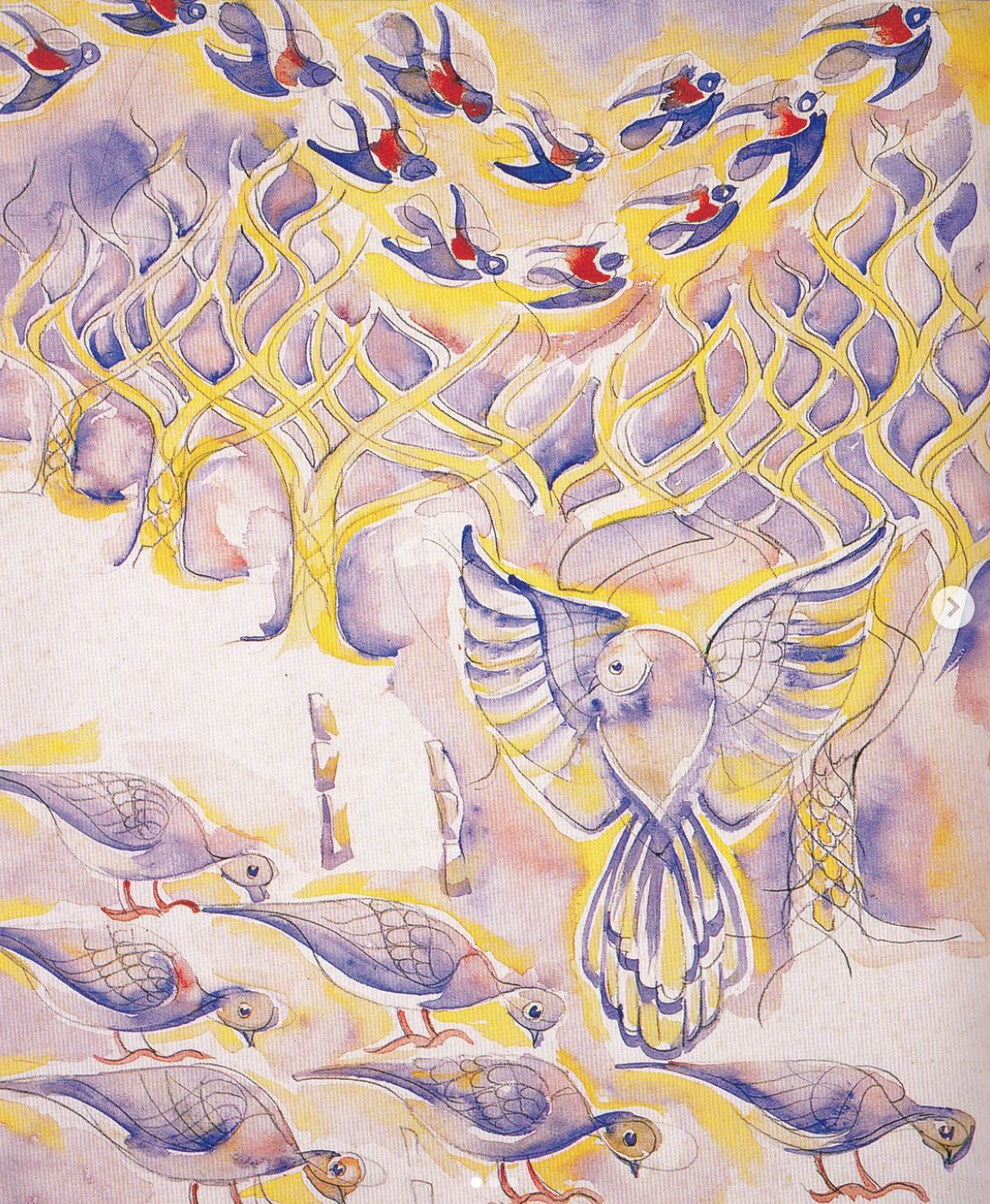According to the Walter Anderson Museum of Art in Ocean Springs, Mississippi, Walter Anderson's paintings, drawings, murals, block prints, sculpture, carvings, and writings of coastal plants, animals, landscapes, and people have placed him among the most compelling and singular artists of the 20th century. He is known as an artist, naturalist, and mystic. WAMA also honors his two brothers, Peter Anderson (1901-1984), master potter and founder of Shearwater Pottery, and James McConnell "Mac" Anderson (1907-1998), noted painter and ceramist.
From his childhood through his years at the Pennsylvania Academy of Fine Art, Anderson worked constantly, resulting in a massive body of work. He would work with whatever he could lay his hands on: drift would became sculpture, and the family's walls became murals. He favored inexpensive typewriter paper, illustrating scenes from Don Quixote, or pelicans in flight, or images of his family––some with Audubon-like detail, others shimmering into semi–abstraction. He often painted very quickly; some of his best works are little more than a few expert lines of watercolor. Anderson knew how to use the white space of the page.
But he was more than just a painter or illustrator. In the decades since his death he has been described as "myth-maker, local legend, mystic poet and painter, man of light, inveterate voyager." This reputation comes, in part, from his journals, which reveal a fiercely independent artist, eager to escape what he called "the sordid thing most people call reality." And escape he did, often by bicycle, riding from Mississippi to New Orleans, to Texas, and to Florida—painting as he went.
His journals reveal the day to day routine of someone living more or less outdoors. What he had for breakfast. The birds he saw. These mundane entries are punctuated by poetry and vivid descriptions of his most ecstatic states, which he described as 'halcyon days.' These were his most productive moments. The objects themselves didn't matter much to him––he tossed many of his paintings into his bonfire––preferring to focus on moments of transcendence that he called "realizations"––acts of creativity where he saw himself as a kind of conduit for the unification of the natural world. "Order is here," he wrote, "but it needs realizing."
Text above, (from second paragraph on), by Win Riley who has written and directed a one hour film examining the remarkable life and work of thisGulf Coast artist. PBS broadcast the film and it is available at Win's channel on You Tube. The project won Best Picture and Best Documentary at the Fargo Film Festival. For more, see winriley.com
According to the Walter Anderson Museum of Art in Ocean Springs, Mississippi, Walter Anderson's paintings, drawings, murals, block prints, sculpture, carvings, and writings of coastal plants, animals, landscapes, and people have placed him among the most compelling and singular artists of the 20th century. He is known as an artist, naturalist, and mystic. WAMA also honors his two brothers, Peter Anderson (1901-1984), master potter and founder of Shearwater Pottery, and James McConnell "Mac" Anderson (1907-1998), noted painter and ceramist.
From his childhood through his years at the Pennsylvania Academy of Fine Art, Anderson worked constantly, resulting in a massive body of work. He would work with whatever he could lay his hands on: drift would became sculpture, and the family's walls became murals. He favored inexpensive typewriter paper, illustrating scenes from Don Quixote, or pelicans in flight, or images of his family––some with Audubon-like detail, others shimmering into semi–abstraction. He often painted very quickly; some of his best works are little more than a few expert lines of watercolor. Anderson knew how to use the white space of the page.
But he was more than just a painter or illustrator. In the decades since his death he has been described as "myth-maker, local legend, mystic poet and painter, man of light, inveterate voyager." This reputation comes, in part, from his journals, which reveal a fiercely independent artist, eager to escape what he called "the sordid thing most people call reality." And escape he did, often by bicycle, riding from Mississippi to New Orleans, to Texas, and to Florida—painting as he went.
His journals reveal the day to day routine of someone living more or less outdoors. What he had for breakfast. The birds he saw. These mundane entries are punctuated by poetry and vivid descriptions of his most ecstatic states, which he described as 'halcyon days.' These were his most productive moments. The objects themselves didn't matter much to him––he tossed many of his paintings into his bonfire––preferring to focus on moments of transcendence that he called "realizations"––acts of creativity where he saw himself as a kind of conduit for the unification of the natural world. "Order is here," he wrote, "but it needs realizing."
Text above, (from second paragraph on), by Win Riley who has written and directed a one hour film examining the remarkable life and work of thisGulf Coast artist. PBS broadcast the film and it is available at Win's channel on You Tube. The project won Best Picture and Best Documentary at the Fargo Film Festival. For more, see winriley.com
Inscription
STAND SURE
















